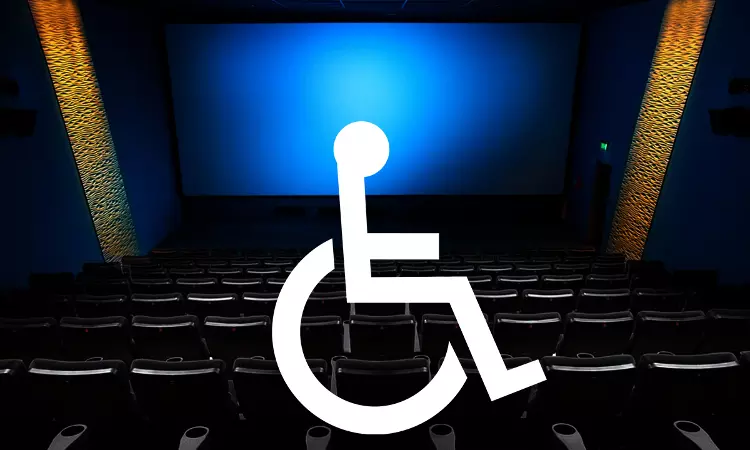Making Cinema Accessible To Everyone
Kartikey Singh
28 Jan 2023 8:30 AM
The Delhi High Court on January 16, directed the producers of the upcoming movie ‘Pathaan’ (Yash Raj Films), to make the movie accessible for hearing and visually-impaired persons. The producers of the film were directed to include audio description, close captioning and subtitles for the movie's over-the-top (OTT) release. This is a welcome step but more needs to be done...
The Delhi High Court on January 16, directed the producers of the upcoming movie ‘Pathaan’ (Yash Raj Films), to make the movie accessible for hearing and visually-impaired persons. The producers of the film were directed to include audio description, close captioning and subtitles for the movie's over-the-top (OTT) release. This is a welcome step but more needs to be done to strengthen the entertainment accessibility rights of differently-abled in the theatres.
As per the 2011 Census report, there are 2.68 crore persons with disabilities (PWD) in India. The Rights of Persons with Disabilities Act, of 2016 (RPWD Act) was enacted to ensure that they enjoy their rights equally with others. The Act was implanted to realize the principles enshrined under the United Nations Convention on the Rights of Persons with Disabilities, 2006 to which India is a signatory.
Scope of the Act
The RPWD Act of 2016 covers disabilities such as physical disability, hearing impairment, visual impairment, and speech and language disabilities among others. Respect for the inherent dignity and individual liberty, effective participation and inclusion in society are the principles stated to be achieved by the act for the empowerment of persons with disabilities (PWD). Part VIII of the Act cast responsibility upon the appropriate governments to provide access to transport, communication technology, and consumer goods and to make existing infrastructure and premises accessible to PWD. Section 42 of the RPWD Act, 2016 casts a duty upon the appropriate government to take measures to ensure that all print, audio and electronic media content is available in formats accessible to PWD.
Failed in achieving its objective
RPWD of 2016 was enacted with the goal of ensuring equal rights for access to cultural and recreational activities such as cinema. However, despite its intentions, the act has failed in its efforts to fully realize this goal when it comes to cinema access. Most films which are released in India are not catering to disabled persons despite the statute having been enacted more than 5-6 years ago. There are several reasons why this is the case.
One major reason is the lack of physical accessibility in cinemas. Many cinemas in India are located in older buildings that were not designed with accessibility in mind, and as a result, they lack basic accessibility features such as ramps, elevators, and accessible restrooms. This makes it difficult, if not impossible, for individuals with mobility impairments to enter the building and enjoy a movie. A study by the National Centre for Promotion of Employment for Disabled People (NCPEDP) shows that only 1% of cinemas in India are fully accessible to individuals with disabilities.
Another significant barrier faced by differently-abled individuals when it comes to accessing cinemas is the lack of captioning and audio description services. Many cinemas in India do not provide these services, making it difficult for individuals with visual or auditory impairments to fully engage with the movie. This not only limits their access to the cultural and recreational benefits of cinema but also reinforces societal attitudes of marginalization and exclusion.
Furthermore, a lack of funding is also a significant barrier to the implementation of the act. The RPWD of 2016 requires significant financial resources to be allocated for the retrofitting of public buildings, the provision of assistive devices, and other measures to ensure the rights of differently-abled individuals. However, the government has not allocated sufficient funds for these purposes, making it difficult for the act to be fully implemented.
The situation in other countries
In other countries, the situation is somewhat better. For example, in the United States, the Americans with Disabilities Act (ADA) requires that all new and altered buildings, including movie theatres, be accessible to individuals with disabilities. Additionally, the Federal Communications Commission (FCC) has adopted regulations requiring that closed captioning be provided on all television programs, including movies shown on television.
In certain foreign countries, the theatres themselves make provisions for headphones to be plugged into the seats in the theatre, through which audio description is relayed in an audio format. However, in India, such facilities are not available in most film theatres.
Equal access to all
In the case of Vikash Kumar vs UPSC and Ors., the Supreme Court in consonance with the reasonable accommodation principle mandated the State and private parties to provide additional support to PWD to ensure their complete and effective involvement in society. If persons with disabilities are not provided with the additional support, then the constitutionally guaranteed fundamental right to life under Article 21, right to equality, right to freedom will ring hollow., the judgment said.
To solve the problem of ensuring cinema access to everyone in India, a comprehensive approach is needed. One solution would be for the government to enforce the Rights of Persons with Disabilities Act, of 2016 to achieve the principles on which it is laid down. Additionally, the government can provide incentives for cinemas to retrofit existing buildings to make them more accessible and can also provide funding for captioning and audio description services. The private sector can also train its staff to assist individuals with disabilities. This not only benefits the differently-abled population but also helps to promote a more inclusive society.
A comprehensive approach that includes government enforcement of existing laws and regulations, private sector initiatives, and incentives for cinemas to retrofit existing buildings and provide captioning and audio description services is needed to solve the problem. By working together, we can ensure that all individuals have equal access to the cultural and recreational benefits of cinema.
Views are personal

